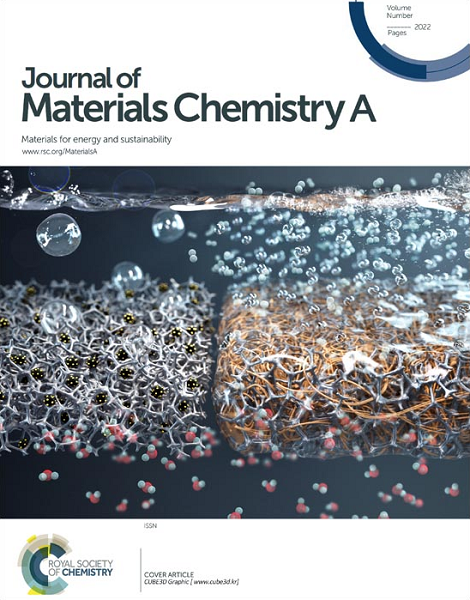Polymerization of succinonitrile on garnet surface for preparing single-ion conducting composite solid-state electrolyte
IF 10.7
2区 材料科学
Q1 CHEMISTRY, PHYSICAL
引用次数: 0
Abstract
Constructing composite solid electrolytes (CSE) with Li-ion-enriched space charge layers to achieve single-ion conducting properties and higher ionic conductivity remains challenging. In this work, CSE was prepared using succinonitrile (SCN) and Li6.4La3Zr1.4Ta0.6O12 (LLZTO). The nitrile groups in SCN spontaneously underwent polymerization reactions induced by oxygen and lanthanum atoms on LLZTO surfaces at 90 °C, generating a polymer coating (pSCN) with conjugated C=N structure. Furthermore, the conjugated C=N structure in the polymer fostered strong electrostatic interactions with LLZTO, promoting the formation of a space charge layer and enabling rapid Li-ion conduction at the pSCN/LLZTO interface. The flexible cellulose-based composite electrolyte membranes containing 60 wt% LLZTO, named as CSE60-cellulose membranes, with a thickness of 35 μm, exhibited single-ion conducting behavior with a Li+ transference number of 0.89, ionic conductivity of 3.54 × 10-5 S cm-1 at 30 °C, and an electrochemical window from 0 to +4.7 V (vs. Li+/Li). The Li/Li symmetric cell using the CSE60-cellulose membrane achieved long-term Li deposition/stripping for 2500 hours. The Li/CSE60-cellulose/LiNi0.5Mn1.5O4 (LNMO) cell was cycled in the voltage range of 3.5 V - 4.9 V and displayed excellent cycling performance at 1C with a capacity retention of 88.59% over 200 cycles at 35 °C. It retained 84.08% capacity at a 2C rate compared to that at 0.1C. The single-ion conducting CSE membrane, prepared via the self-polymerization of SCN on the LLZTO surface, is proved to be a promising solid electrolyte for advanced solid-state Li metal batteries.琥珀腈在石榴石表面聚合制备单离子导电复合固态电解质
构建具有富锂离子空间电荷层的复合固体电解质(CSE)以实现单离子导电性能和更高的离子电导率仍然是一个挑战。本研究以丁二腈(SCN)和Li6.4La3Zr1.4Ta0.6O12 (LLZTO)为原料制备了CSE。在90 ℃温度下,氧和镧原子在LLZTO表面自发聚合,生成共轭C=N结构的聚合物涂层(pSCN)。此外,聚合物中的共轭C=N结构与LLZTO形成了强静电相互作用,促进了空间电荷层的形成,使锂离子在pSCN/LLZTO界面上快速导电。含有60 wt% LLZTO的柔性纤维素基复合电解质膜,称为CSE60-cellulose膜,厚度为35 μm,具有单离子导电行为,在30 ℃下,Li+转移数为0.89,离子电导率为3.54 × 10-5 S cm-1,电化学窗口为0 ~ +4.7 V (vs. Li+/Li)。使用cse60纤维素膜的Li/Li对称电池实现了2500 小时的长期锂沉积/剥离。Li/CSE60-cellulose/LiNi0.5Mn1.5O4 (LNMO)电池在3.5 V ~ 4.9 V的电压范围内循环,在1C下表现出优异的循环性能,在35 °C下200次 循环的容量保持率为88.59%。在升温2℃时,与升温0.1℃时相比,其容量保持了84.08%。通过在LLZTO表面自聚合SCN制备的单离子导电CSE膜,被证明是一种很有前途的先进固态锂金属电池电解质。
本文章由计算机程序翻译,如有差异,请以英文原文为准。
求助全文
约1分钟内获得全文
求助全文
来源期刊

Journal of Materials Chemistry A
CHEMISTRY, PHYSICAL-ENERGY & FUELS
CiteScore
19.50
自引率
5.00%
发文量
1892
审稿时长
1.5 months
期刊介绍:
The Journal of Materials Chemistry A, B & C covers a wide range of high-quality studies in the field of materials chemistry, with each section focusing on specific applications of the materials studied. Journal of Materials Chemistry A emphasizes applications in energy and sustainability, including topics such as artificial photosynthesis, batteries, and fuel cells. Journal of Materials Chemistry B focuses on applications in biology and medicine, while Journal of Materials Chemistry C covers applications in optical, magnetic, and electronic devices. Example topic areas within the scope of Journal of Materials Chemistry A include catalysis, green/sustainable materials, sensors, and water treatment, among others.
 求助内容:
求助内容: 应助结果提醒方式:
应助结果提醒方式:


